We had been on a road trip to Karnataka in February 2015; however due to time constraint we were unable to visit one of the best archaeological sites Badami and Hampi. Both places were on our must visit list and finally we planned in October.
To avoid the length of my travel blog, I have divided it into 2 parts. You can read the first part of travel blog at
Charismatic Badami - Pattadakal and Aihole Road trip
Travelers for this trip were me and wife Renuka.
 |
| Stone Chariot at Hampi |
About Hampi:
Hampi is also known as Hampe located in north Karnataka. It is situated on the bank of Tungabhadra River. Hampi is one of the famous historical villages in India and UNESCO World Heritage Site, listed as the Group of Monuments at Hampi. The name is derived from Pampa, which is the old name of the Tungabhadra River.
Hampi was the capital of the Vijayanagara Empire from 1336 to 1565. It was chosen as the capital because of its strategic location, protected by Tungabhadra River on one side and surrounded by unconquerable hills on the other three sides. Hampi is known for its beauty of the temples and architectures and monuments spread out in whole city.
Day 2: 3rd Oct 2015: Badami - Hampi:
We spend our Day 1 in Badami, Pattadakal and in Aihole. We left Aihole in the evening for our next destination i.e. Hampi. Drive from Aihole to Hampi was Aihole – Hungund – Kushtagi – Munirabad – Hosapete (Hospet) – Hampi. We reached at Hampi by 6.30 PM.
Travel Blog:
Charismatic Badami - Pattadakal and Aihole Road trip
We had not done any hotel booking in advance hence our first task was to search for hotels. Many locals suggested to stay in Hampi bazar. We checked few hotels but problem was we could not take our vehicle in the bazar area. We would have to park your vehicle 500 meter away and carry luggage to room. We got to know about Padma guest house which was the outside bazar area with proper parking space, therefore we decided to stay here. We checked in and went out for a walk in the Heritage village.
 |
| Virupaksha Temple |
We visited Virupaksha Temple which was a stone’s throw away distance from the guest house. Virupaksha Temple is also known as the Pampavathi temple. It predates the founding of the Vijayanagara Empire. This is the only temple where worship process is followed in Hampi. Temple has huge 160 foot high Gopura (entrance of a temple in south India) tower. Temple is dedicate to Shiva and along with Lord Shiva the temple complex also contains shrines of the Bhuvaneshwari and Pampa. The doors of this temple are beautifully carved. The ceiling has been decorated magnificently. One of the major attractions in temple is the Laxmi elephant and her blessings. If you give her money or a banana then she gives you blessings by keeping her trunk on your head. It was an amazing site to watch.
 |
| Virupaksha temple tower, Hampi |
After spending some time in the temple, we decided to explore Hampi bazar followed by dinner. Hampi bazar consists of a variety of shops. Hampi is often visited by foreigners hence you will find that the market here are similar to the markets in Goa. Hampi bazar also consists of nice restaurants which serves worldwide cuisine. We tried Gopi restaurant. Most of the restaurants have free Wi-Fi facility as only BSNL mobile network works in Hampi village. We purchased a guide book and a map from one of the shops. Hampi shops and restaurants close at 10 PM.
 |
| Hampi Bazar |
Expense:
- KA Toll 1: INR 45/-
- KA Toll 2: INR 45/-
- KA Toll 3: INR 34/-
- Padma Guest house: INR 1600/- for 2 nights (Non AC Room)
- Dinner at Gopi restaurant: INR 450/- for 2 person
Day 3: 4th Oct 2015: Hampi:
We woke up by 5:30 AM but it was raining. Most of the Heritage sites open at 6 or 7 AM. Our plan is to start the day with Lord Shiva’s Darshan at Virupaksha Temple. We took blessings of Elephant Laxmi and spent some time with her.
As Vijaya Vittala temple opens at 8:30 AM hence our first destination was Hazara Rama Temple. Reason behind the temple name is not known but it is close to the King’s Palace. Being near the palace, it was a temple for the royal family. King Krishna Devaraya built it in 1513. This temple belongs to Royal family hence it is not as huge as the other temples in the city. Major attraction of this temple is its walls. Every inch of the outer wall is filled with carvings depicting scenes from the Ramayana. Figures are carved in series, mainly of elephants and horses. There are figures from Ramayana that are worth watching.
 |
| Hazara Rama Temple |
 |
| Hazara rama temple wall carving |
 |
| Hazar rama temple, Hampi |
Opposite to the Hazara Rama temple, you can view some ruined temple parts. Also there is temple pillar and a deep well. As per history, villagers sacrificed their sheep and buffaloes on the day of Mahanavami.
 |
| Temple Pillar, Hampi |
As it was 8 AM in clock, we decided to visit Vijaya Vittala temple. While returning, we decided to visit places like Mahanavami Dibba, stepped tank, Lotus mahal, Queen’s bath and elephant stable. Vijaya Vittala Temple is situated northeast of Hampi, close to Tungabhadra River. You need to drive towards Kamalapur and then take left towards Nimbapura village for the temple. Private vehicles are not allowed till the temple area. You need to park your vehicle 2 km before the temple. Huge parking area is available and battery operated vehicle service takes you to the temple.
 |
| Vijaya Vittala Temple, Hampi |
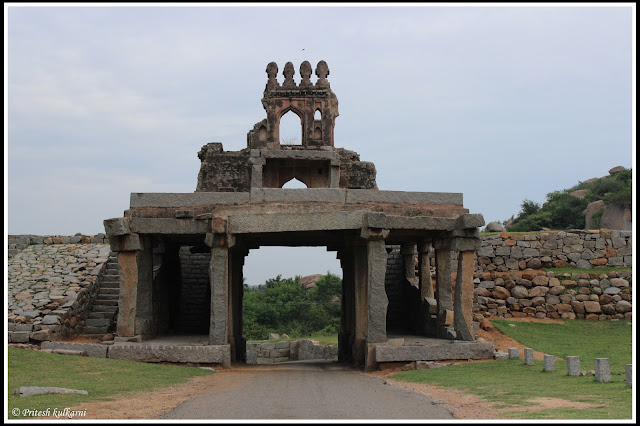 |
| Talarighatta Gate at Vijaya Vittala temple, HAmpi |
Vijaya Vittala Temple is dedicated to Lord Vittala who is also known as Vithoba / Panduranga an aspect of Vishnu worshipped in the Maratha country. We reached at the temple by 8.30 AM. Vijaya Vittala Temple is the main attraction in Hampi. We hired a guide to understand the significance for temple and the beautiful carvings. Entrance Gopura of temple is very beautiful. We got to know from the guide that it was a multi storey Gopura at that time. In 14tth century King Devaraya 2 (1424-1446) had built this temple and King Krishna Devaraya (1509-1529) developed in further.
 |
| Vijaya Vittala temple, Hampi |
One of the major attractions in the temple area is Stone chariot or Ratha. This is one of the three famous stone chariots in India, the other two being in Konark and Mahabalipuram. This stone chariot was built in order to commemorate victory over Orissa kingdom. Some say, the King was inspired by Konark temple from Orissa and built same one here. During those days, it was painted in red, yellow and green color which faded out due to weather. Still you can see some paint on the Chariot. Originally the Chariot had horse structures pulling this chariot but it was destroyed and then it was replaced by two elephants by government. The tails and the rear legs of the horses can be still seen just behind these elephant sculptures.
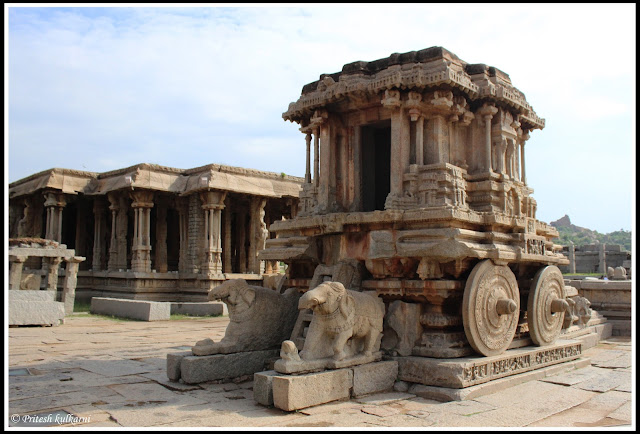 |
| Stone Chariot at Hampi |
Famous chariot consist of stone wheels. The wheels of the Ratha can be rotated but the government has cemented them to avoid the damage caused by the visitors. You can see small ladder in front of the Ratha. Originally the ladder was big but it was damaged. It was one of the best sculptures from Hampi.
 |
| Color on Stone Chariot |
Next to the Stone Chariot, you can see the main hall in front of Vittala temple which is called as Maha-Mandapa. It consists of four open halls within mainly named as East, south, north and central hall. The lowermost part of the hall is carved with a chain of horses, its trainers and the traders. The main highlight of the Maha-Mandapa is its richly carved giant monumental pillars. It is also known as musical pillars. Along with this there are sculptures with musicians, drummers and dancers. Locals say, during old time this hall was used for dance and pillars were used to create musical sound. Overall designs, images, paintings and carvings are simply masterpieces.
 |
| Musical Pillars at Vittala Temple |
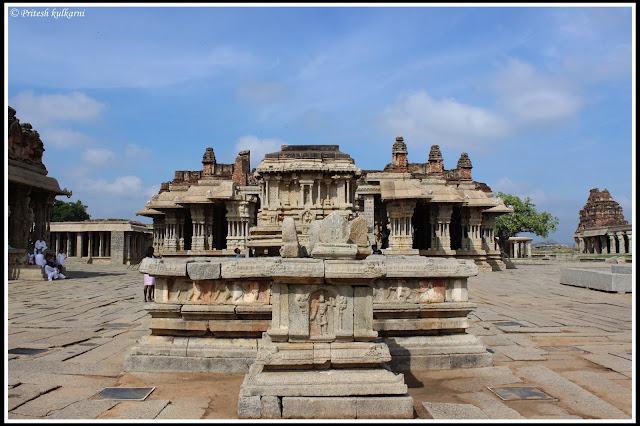 |
| Vijaya Vittala temple |
You can see the arrangements in stone which were used as outlet for rain water, hooks on the ceiling which were used to cover entire hall by cloth to maintained privacy during dance shows. There is also an image of a bull and elephant with a share head etc. Inner or main part of temple is richly decorated. The inner shrine is lacking of any idol. A narrow and unlit passageway encloses the inner shrine. A few steps on either sides of the shrine’s main door give access to this passage.
 |
| Beautiful carving |
We saw all other places from Temple area. You can spend 3-4 hours easily to see the beautiful carvings. We left this place but I wanted to capture view of entire temple so we climbed a small hill near the temple. Road to the temple was one of the best market in the world at that era. It was famous for horse trade. Traders from all over world came and exchanged their best horses for gold and diamonds in Hampi. You can see such sequence of sculptures. You can see ruins of the market on both side of the road which leads to the temple.
 |
| Market view |
 |
| Market outside temple |
 |
| Market view |
 |
| Inside market |
Our next destination was Queen’s Bath which was constructed by King Achyuta Raya for the women of the royal family of Vijayanagara. Though named as the Queen’s Bath, it was in all probability used as the private bathing chamber of the king and his queens. The building has lost its glory. Queen’s Bath was built in the Indo-Islamic style of architecture. The central bath area was open to the sky but there used to be a canopy, probably made of wood covering it and was later burnt down.
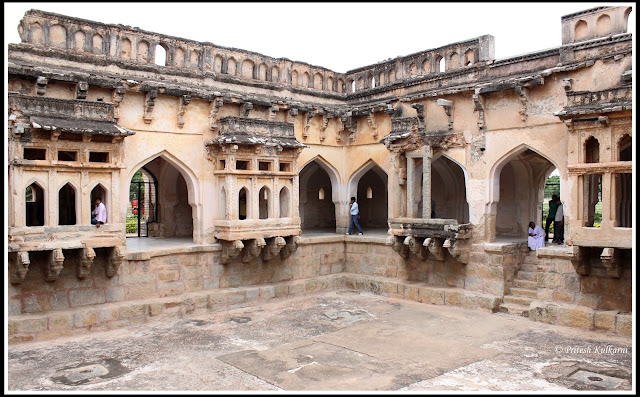 |
| Queens Bath, Hampi |
Center part of the bath is surrounded by window-like balconies projecting into the bath. The roof of the Queen’s Bath is made up of several domes and you can see the unique detailing on each dome. There is a bridge to cross the moat and reach the bath. It is believed that the moat was designed to prevent anyone from entering the building while the bath was in use.
After visit to the Queen Bath, we again join the rough road to visit remaining places from Royal Enclosure. We visited Mahanavami Dibba. The term “Dibba” in Kannada means “High level platform or High ground”. This is the tallest structure in the royal palace area. Mahanavami Dibba was built after victory over Orissa. Vijayanagara was famous to host the rich and royal for the Dasara Celebrations every year. It was used by kings as platform to celebrate the 9 days long splendid function religiously known as Mahanavami festival. King would sit on the ornamental platform to watch the army march-past, war games and royal processions that were held as part of festival. Sculptures and figures of hunter, animals and scenes from Purana are some beautiful carvings found here.
 |
| Mahanavami Dibba |
Our next destination was the Stepped tank or Pushkarni tank. The tank is 22m wide and 7m deep which means 22/7 i.e. ratio of the Pi. It was discovered in year 1981 by member of ASI. Construction and design is marvelous. Due to Post monsoon time, only 3-4 levels were visible.
 |
| Stepped Tank, Hampi |
There are many places to visit within the royal palace. One of them is a secret chamber. Center portion of this chamber is open to sky but it was an enclosed chamber which was used for secret meetings with the king. Few meters away from the Mahanavami Dibba, you can see a large sized tank which was used as swimming pool for the royal children. Water to all these tanks was fed by an extensive network of canals.
 |
| Secret chamber, Hampi |
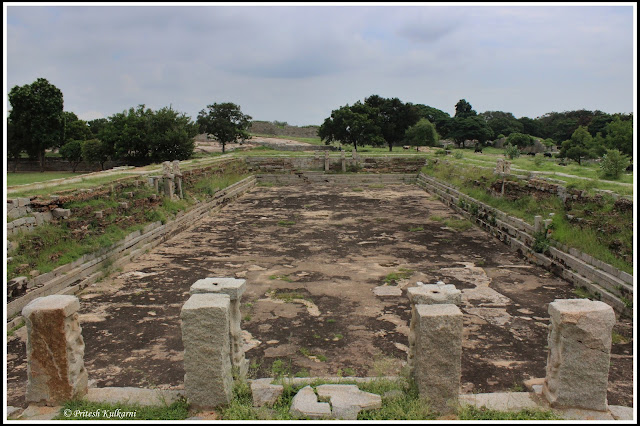 |
| Royal Tank, Hampi |
 |
| Royal Enclosure |
At short distance away from the Royal Enclosure, there is a beautiful place such as Zenana Enclosure which consists of Lotus Mahal and watchtowers. Queen palace is surrounded by high walls on all sides. Lotus Palace is Indo-Islamic architectural style palace which was a meeting place for the royal women. It is two storey palace with beautiful carving. The watch towers from Zenana Enclosure was always guarded by female warriors. Out of non-religious buildings Lotus Mahal has an attractive photographic feature.
 |
| Lotus Mahal (Queen palace), Hampi |
A short walk from lotus palace, you can reach at the Elephant Stables. For me, it was mystery that how come royal elephants were neighbors of Royal woman. Elephant stable consist of total 11 huge domed tall compartments to keep the best 11 royal elephants. This impressive structure is built in Indo-Islamic architectural style. All elephant chambers are connected with arched openings. The domes are of various types such as circular, fluted, octagonal and ribbed. Center hall or chambers is large in size, probably used to keep the king’s own elephant. Central chamber and tower look like a temple. At the rear of each hall are small manhole type openings for the mahouts to enter the elephant compartments.
 |
| Elephant stable, Hampi |
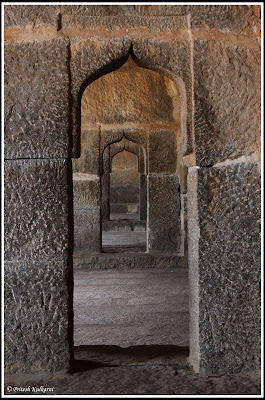 |
| Inter connected Stable |
 |
| Elephant Stable, Hampi |
There is another small building which was house of Mahoot (Elephant’s rider). The open area in front of the building was a parade ground for the elephants. This is a magnificent structure in Hampi and must visit place for sure. It was 1.30 PM in the clock and we decided to go back to Hampi for lunch. We had our lunch in Hampi bazar and took a power nap before we began with our evening sightseeing.
In the evening, we decided to spend more time to explore Matanga Hill for perfect sunset view and Achyuta Raya’s Temple. The road opposite to the Virupaksha Temple goes to Matanga hill. Achyuta Raya’s Temple is behind Matanga hill. But best way to see both places is to walk along the river to visit Achyuta Raya’s Temple first and then there is a way to climb up the hill. Plan in such a way that you will reach on the hill before sunset.
 |
| Way to Achyut Raya temple |
Way to Achyuta Raya Temple is close to river and is a very nice trail. We saw many Coracle Boats lying down there on the bank of the river waiting for the tourists. The river and adjacent area consist of heavy stone and trees offer beautiful view. We reached at Achyuta Raya Temple on the other side of the hill.
In front of the Achyuta Raya Temple, there is a row of ruined pavilions on the both sides. During the empire time, this was a flourishing market of gems, pearls etc. There is a ruined market street in front of temple in a semi secluded valley formed by two hills namely Gandhamadana and Matanga. Roughly half a kilometer long and about 50 meters wide, this street was once thronged by merchants even from faraway places. A large rectangular tank associated with Achyuta Raya’s temple is located at the northwest end of the street. It is known as Pushkarni tank.
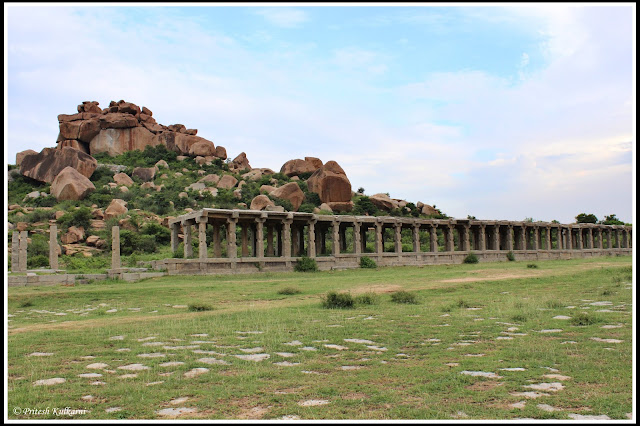 |
| Market outside Achyuta Raya temple |
 |
| Pushkarni tank, Hampi |
 |
| Pushkarni temple |
Achyuta Raya Temple is built in 1534 by Salakaraju Tirumaladeva, high officer in King Achyuta Deva Raya’s court. It was dedicated to Lord Tiruvengalanatha, who is none other than Lord Vishnu.
 |
| Achyuta Raya Temple, Hampi |
The main shrine is located at the center of two rectangular concentric courtyards. In the compound of this temple, we spotted some of the finest carved pillars. Two huge towers placed one behind the other are ruined. We get access to temple courtyards from here. On entering the inner court there is a chamber facing the portal and a small chamber where an idol of Garuda was placed. Temple is one of the magnificent and major temples of Hampi.
 |
| Inside Achyuta Raya Temple |
 |
| Achyuta Raya temple Shrine, Hampi |
Our next destination was Matanga hill which is a view point of hampi. There are two routes to climb the hill, one from opposite side of Virupaksha Temple and another from Achyuta Raya Temple. We climbed from the Achyuta Raya Temple side and came down by the other route. It takes around 20-25 mins to climb if you are a good hiker else may take 45 mins. It is the heighted point in Hampi and mainly famous for Sunrise and sunset view. You have to climb stone steps and some rocky patches at the end. End part is a bit slippery if it is raining. This is a nice small hiking route hence young and fit people prefer this place to visit.
 |
| Way to Matanga Hill |
 |
| Achyuta Raya temple view |
 |
| View from Matanga Hill |
We reached at the top by 5.30 PM and spent around an hour. Due to cloudy weather we unable to enjoy the sunset but trust me; view of Hampi from this place is simply breathtaking. You can get best aerial view of Achyuta Raya Temple from hill top. If you have good telephoto lens or binoculars then it’s fun to find all the tourist spots from the hill. View of Rocky Mountains, River, Achyuta Raya Temple, Virupaksha temple, Krishna temple, Vijaya Vittala temple etc. is magnificent. We were the only tourists at top and enjoyed beautiful evening before we came back.
 |
| View from Hill |
 |
| View from Matanga Hill |
 |
| View of Bal Krishna temple from Hill |
We visited Virupaksha Temple once again and then went to the Hampi bazar. We had heard a lot about the Mango tree restaurant from the locals so we had dinner there. Food was good but not must visit restaurant. By 10.30 PM we came back in hotel for rest.
 |
| Virupaksha temple at night |
Expense:
- Shuttle battery car ride: INR 40/- for 2 person (To-and-Fro journey)
- Vittala Temple entry: INR 20/- (for 2 person)
- Vittala Temple Video camera chargers: INR 25/- (No chargers for camera)
- Guide at Vittala Temple: INR 250/-
- Coconut water at Vittala Temple: INR 20/- per coconut
- Elephant stable and Lotus palace entry free: INR 20/- for 2 person
- Elephant stable and Lotus palace video camera chargers: INR 25/- (No chargers for camera)
- Lunch in Hampi Bazar: INR 280/- for 2 people (Starters, Panjabi veg, rice and cold drinks)
- Snacks near Hampi bazar: INR 70/- (Pani puri, bhel, bhaji etc)
- Dinner: INR 410/- for 2 people (Starters and 1 large Pizza)
Day 4: 5th Oct 2015: Hampi - Pune:
This was our last day of Badami-Hampi trip. We planned to leave Hampi by 10 AM and before we left, we planned to visit the remaining tourist places. We woke up by 6AM and left the room by 6.30 AM. Our first destination was Hemakuta hill. Hemakuta Hill Temple Complex is a group of small temples on the hill which consists of Ganesh temple, Jain temple and Krishna temple. It is also a best place to see Virupaksha Temple from an arial view. Road to this hill is on the left side of Virupaksha temple entrance. There are boards which guide you well. You can enter from entrance arch which is the entrance gate for the hill.
Temples are in ruined condition without an idol but overall view of Hampi is nice. I liked this place for better view of Virupaksha temple.
 |
| View of Virupaksha temple |
 |
| Virupaksha Temple |
 |
| Entrance to Hemakuta hill |
As per Mythology, ‘Pampa’ meditated on Shiva by which he was pleased by her dedication for him and married her. Pampa was Manasa putri (mind-born daughter) of Brahma, an incarnation of Parvathi. On the occasion of the divine wedding there was rain of gold on this hill. Gold is also called Hema. Thus it is called as Hemakuta hill. To evidence these legends we find many temples dedicated to Lord Siva here.
 |
| Temples on Hemakuta hill |
 |
| Ruined Temples on hill |
On the other side of Hemakuta hill, there is a very beautiful Ganesh idol temple. The statue of Lord Ganesh is 2.5 meters tall which was constructed in 1506 AD by a merchant from Chandragiri in the memory of King Narasimha II, Vijayanagara. The Ganesh idol is placed inside a pavilion. Stomach of Ganesh resembles mustard seed as such it is identified as “Sasivekalu Ganesha”. You can observe a snake tied around the stomach of the Ganesh idol. As per the mythological stories, it is believed that Ganesh tied that snake to prevent his stomach from getting busted due to overeating.
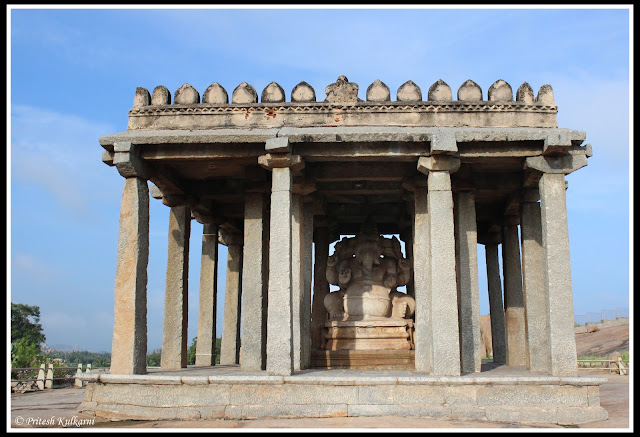 |
| Sasivekalu Ganesha |
We spent around an hour here and left the hill for our next destination which was Narasimha Vigraha also known as Ugra Narasimha. ‘Ugra’ means angry with aggression and ‘Narasimha’ means the Lion headed god. This is one of the main sculptures from Hampi. You will see either Ugra Narasimha or stone chariot pictures as cover photo on any book on Hampi. There is no entry fee and it is open for entire day. Statue was built in year 1528 during the period of King KrishnadevaRaya (1509-30). In 1528, the statue was of goddess ‘Laxmi’ on the lap of god Narasimha but statue of Laxmi had fallen down but is preserved at Kamalapura Museum.
 |
| Narasimha temple |
Lord Narasimha is seen sitting on the coils of Sesha Naga and guarded by lions. Seven headed snake-god spread over on the Lord from behind looks like canopy. Ugra expression can be easily seen in the large eyes. The idol looks grand and marvelous.
 |
| Ugra Narasimha |
Another tourist place, Shivlinga temple is located close to the Ugra Narasimha Statue. Shiv-Linga temple is very small and nothing much to see in it but the Shivaling is quite huge in size standing in the midst of water. It was commissioned by poor women and hence it named Badavi-Ling temple.
 |
| Shivlinga temple, Hampi |
Our second last destination in Hampi was the Underground Shiva temple known as Pathaleshwara temple which is built in year 1442. It opens at 8.30 AM. It is known as underground temple because it was built below ground level. Now days, it is not exactly as underground as such. The shrine and central parts of temple are always under water. Water restricts entry into the central part of the temple. Depending upon the water level we can enter the sanctum area. It is an earliest structure in Hampi.
 |
| Underground Shiva temple |
Our last destination in Hampi was Balakrishna Temple. Currently some restoration work is in progress at the entrance to strengthen the structure. Balakrishna temple is a temple dedicated to Lord Krishna built by the ruler Krishnadeva Raya in 1513. Locals say, Balakrishna temple was built to remember his victory over king of Orissa Prataparudra Gajapati. In any battle, the winner could take anything of the defeated king. In that victory Krishnadeva Raya seized an idol of Balakrishna (child Krishna) as the war trophy. He built this temple to consecrate the deity. There is no Idol in the shrine whereas it is housed safely in Government Museum at Madras.
 |
| Road outside Bal-Krishna temple |
 |
| BalaKrishna Temple, Hampi |
Like other main temples, this temple also consists of 3 entrances. Pictures of Bal-Krishna are carved in the wall at the entrance and are amazing to watch. Overall temple architecture looks similar to Vijaya Vittala Temple. The walls, row of pillars, and dome of temples are imprinted with beautiful, fine carvings. They tell you about Bhagavata and tales of Krishna. In front of Balakrishna temple, there is huge open ground with ruined building on both sides. It was used for a large popular market at that time.
 |
| Balakrishna temple Shrine |
 |
| BalaKrishna Temple side view |
 |
| Market ruins outside BalaKrishna temple |
It was 10 AM in the clock and we decided to leave Hampi. We checked-out from the hotel and left for Pune by 11 AM. We had our lunch by 3 PM after crossing Hubali. Till sunset Renuka enjoyed driving and I took charge of vehicle in Maharashtra. We reached home safely after the magnificent trip to Badami and Hampi by 10.00 PM.
 |
| Its time to say Bye Hampi... |
Expense:
- Car petrol at Hospet: INR 2000/-
- Snacks at Hospet: INR 78/- (Dosa and idle Sambar)
- KA Toll 1: INR 20/-
- KA Toll 2: INR 40/-
- MH Toll 1 + 2: INR 136/- (One way)
- MH Toll 3: INR 55/- (One way)
- MH Toll 4: INR 80/- (One way)
Contact numbers:
- Padma hotel: 08394-241330, 08394-241331, 09480152979.
- Prakash Guide from Hampi: 09449912685
- Katti Guide Hampi (Knows Marathi language): 09480510246
 |
| Stone entrance at Hampi |
 |
| Entrance to King Balance |
 |
| From Matanga Hill |
I will try to upload more and more travel blogs. Thanks for reading this Travel Blog. Happy traveling.
Pritesh Kulkarni,






























































